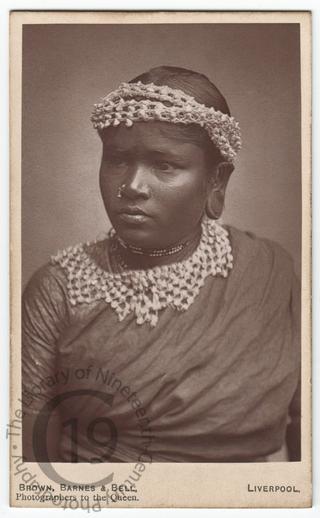
International Exhibition at Liverpool
A carte-de-visite portrait of one of the occupants of 'the Indian Village' at the International Exhibition of Navigation, Commerce and Industry held in Liverpool in 1886.
Among the most popular attractions at the fair were a life-size replica of the Eddystone Lighthouse, Grace Darling’s lifeboat, the West African Ashanti Palace, a family of Laplanders, accompanied by three reindeer, and the Indian Village. This last housed some fifty ‘natives of India and Ceylon,’ including artisans at work, nautch girls, ‘devil’ dancers, conjurors and a snake charmer called Natchoomiya.
The fair was opened by Queen Victoria on 11 May 1886. According to a report that morning in the Liverpool Mercury: 'The Queen will drive past the lighthouse and various pavilions. The native Indians, Chinese, Ashantees, and Laplanders, with their characteristic travelling appliances and animals, will be in the grounds for Her Majesty's inspection.'
A report in the same newspaper two months later mentioned 'the Indian Pavilion, the Tobogganing Track, the Lapland Village, the Gipsy Encampment, the Ashantee House, the jinrikishas [rickshaws], the African hammocks, the Aylesbury Dairy, Kirkland's Working Bakery, the School of Cookery, the Queen's Rooms, and the Mayor's Reception Rooms' as well as 'the Chinese Pagoda,' which it described in great detail (Liverpool Mercury, 6 July 1886).
The daily highlight at the exhibition was a procession of animals specially imported by William Cross, the well-known naturalist and dealer in wild animals. According to the printed information on the back of this carte, the procession comprised ‘performing elephants, camels, zebras, Brahmin bulls, llamas, dogs, etc.’
Photographed by Brown, Barnes and Bell of Liverpool.
Code: 126543




